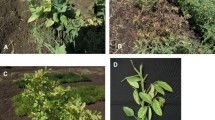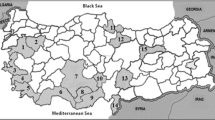Abstract
Twelve virus isolates from pea, broad bean, red clover and yellow lupin have been compared with the B25 strain of bean yellow mosaic virus (BYMV-B25), the E198 strain of pea mosaic virus (PMV-E198) and the pea necrosis virus (E178), which were described earlier (Bos, 1970).
On the basis of host ranges, symptoms and bean and pea varietal reactions most isolates could be classified into three groups, representatives of which did not differ appreciably serologically. These groups were considered to be typicalbean yellow mosaic virus isolates (E212, L1, B25),pea yellow mosaic strain isolates of BYMV (E198, E204, Kow28) andpea necrosis strain isolates of BYMV (E197, E199, E221). From these results and from a survey of literature it is concluded that PMV is only a strain of BYMV.
The pea necrosis virus (E178), described earlier as a distinct entity, is still considered a different virus. A severe pea necrosis isolate (Kow14) resembled E178 in many respects and was also more distantly related serologically to the BYMV isolates tested. Four other virus isolates from pea and broad bean (E196, Vf15, Vf18 and Vf30) could not yet be identified. Lettuce mosaic virus (LMV) was found to be serologically rather closely related to BYMV.
Results of cross-protection tests were erratic, and particle length measurements were no help in differentiating the strains and viruses studied.
Samenvatting
Twaalf virusisolaten uit erwt, tuinboon, rode klaver en gele lupine werden vergeleken met de eerder beschreven (Bos, 1970) B25-stam van het bonescherpmozaïekvirus (BYMV), de E198-stam van het erwtemozaïekvirus (PMV) en het erwtenecrosevirus (E178) (Tabel 1).
Op grond van waardplantreeksen, symptomen en de reacties van bone- en erwterassen (Tabel 2) konden de meeste isolaten worden ingedeeld in drie groepen, waarvan vertegenwoordigers serologisch niet duidelijk verschilden (Tabel 5). Een groen erwteisolaat (E212) en een met zaad overgaand isolaat uit gele lupine (L1) bleken typische bone-isolaten van hetbonescherpmozaïekvirus, dat duidelijke symptomen veroorzaakt in de meeste bonerassen en groen mozaïek in erwt (Fig. 1A) en tuinboon. InChenopodium amaranticolor geven deze isolaten in tegenstelling tot alle andere getoetste isolaten gewoonlijk systemische symptomen, die met het lupineïsolaat zeer hevig zijn (Fig. 4A).
Twee erwtegeelmozaïekisolaten (E198 en E204) en een isolaat uit rode klaver (Kow28), die geelmozaïek in erwt en tuinboon doen ontstaan en slechts milde symptomen in een deel der op het bonescherpmozaïekvirus reagerende bonerassen, werden opgevat als behorend tot deerwtegeelmozaïekstam van het bonescherpmozaïekvirus.
Drie erwtenecrose-isolaten (E197, E199, E221), die necrose veroorzaken in erwt (Fig. 3) en tuinboon (Fig. 2) terwijl de bonerassen gewoonlijk overgevoelig bleken, werden beschreven alserwteecrosestammen van het bonescherpmozaïekvirus.
De drie voor erwtemozaïek onvatbare erwterassen bleken immuun voor alle isolaten van het bonescherpmozaïekvirus behalve E197, dat een latente systemische infectie gaf in ‘Relonce’.
Het eerder als een aparte eenheid beschreven erwtenecrosevirus (E178) gedroeg zich ook nu duidelijk verschillend van de bonescherpmozaïekvirusisolaten. Het isolaat Kow14, dat in erwt eveneens ernstige necrose veroorzaakte, leek op E178 in de necrose die werd teweeggebracht in erwt en tuinboon, in de lokale vlekken in komkommerzaadlobben en in het ontbreken van systemische necrose inLupinus angustifolius, maar de meeste bonerassen waren onvatbaar voor Kow14. Het was ook serologisch minder nauw verwant aan de onderzochte bonescherpmozaïekvirusisolaten.
Vier andere virusisolaten uit erwt en tuinboon konden nog niet worden geïdentificeerd. Eén ervan (Vf18) vertoonde een unieke latente systemische infectie in alle drie mozaïekonvatbare erwterassen (Tabel 2).
Resultaten van de premunitieproeven (Tabel 3) waren wisselvallig en nergens werd een volledige bescherming verkregen. Deeltjeslengtemetingen (Tabel 4) bleken niet van nut bij de onderscheiding van de onderhavige stammen en virussen.
Uit de verkregen resultaten en uit een overzicht van de literatuur wordt tenslotte geconcludeerddat het erwtemozaïekvirus opgevat moet worden als een stam van het bonescherpmozaïekvirus. Het laatstgenoemde virus is tamelijk nauw verwant aan het slamozaïekvirus, zoals met een antiserum tegen dit virus werd aangetoond.
De variabiliteit van het bonescherpmozaïekvirus en zijn relaties met een groep van nauw verwante virussen wordt verder besproken. Biologische eigenschappen van de onderhavige virussen hoeven niet samen te vallen met de ‘lichamelijke’ eigenschappen van hun deeltjes, inclusief de serologische. De virussen en hun stammen kunnen gemakkelijk worden onderscheiden met behulp van een beperkte reeks van differentiërende waardplantsoorten (Tabel 6). Een indeling van de betrokken virussen op grond van pathogeniteit is zowel van betekenis om praktische redenen, als voor het verkrijgen van inzicht in hun ontstaan.
Similar content being viewed by others
References
Barton, D. W., Schroeder, W. T., Provvidenti, R. & Mishanec, W., 1964. Clones from segregating progenies of garden pea demonstrate that resistance to BV2 and PV2 is conditioned by the same genotype. Pl. Dis. Reptr 48: 353–355.
Bercks, R., 1960. Serologische Untersuchungen zur Differenzierung von Isolaten desPhaseolus-Virus 2 und Ihrer Verwandtschaft mitPhaseolus-Virus 1. Phytopath. Z. 39: 120–128.
Blaszczak, W., 1963. Studies on narrowleavedness of yellow lupin in West Poland. Roczn. Wyzszej Szkoly Roln. Poznań 15: 3–78.
Böning, K., 1927. Die Mosaikkrankheit der Ackerbohne (Vicia faba L.). Forschn Geb. PflKrankh., Berl. 4: 43–112.
Bos, L., 1969a. Some problems in the identification of a necrosis virus of pea (Pisum sativum L.). Proc. 6th Conf. Czechosl. Plant Virologists, Olomouc. Sept. 1967, p. 253–262.
Bos, L., 1969b. Inclusion bodies of bean yellow mosaic virus, some less known closely related viruses and beet mosaic virus. Neth. J. Pl. Path. 75: 137–143.
Bos, L., 1970. The identification of three new viruses isolated fromWisteria andPisum in the Netherlands, and the problem of variation within the potato virus Y group. Neth. J. Pl. Path. 76: 8–46.
Chamberlain, E. E., 1935. Sore-shin of blue lupins; its identity with pea mosaic. N. Z. Jl. Agric. 51: 86–92.
Corbett, M. K., 1958. A virus disease of lupines caused by bean yellow mosaic virus. Phytopathology 48: 86–91.
Cousin, R., 1965. Étude de la sensibilité des variétés de pois au virus de la mosaïque commune du pois, étude génétique de la resistance. Annls Amél. Pl. 15: 23–36.
Cousin, R., 1969. Mosaïque commune du pois. Étude comparée des souches du virus de la mosaïque commune du pois et du virus de la mosaïque jaune du haricot. Nature de la résistance de certaines variétés de pois à ces souches. Annls Phytopath. 1: 201–212.
Demski, J. W., 1968. Local lesion reactions ofChenopodium species to Watermelon mosaic virus 2. Phytopathology 58: 1196–1197.
Doolittle, S. P. & Jones, F. R., 1925. The mosaic disease in the garden pea and other legumes. Phytopathology 15: 763–772.
Goodchild, D. J., 1956a. Relationships of legume viruses in Australia. I Strains of bean yellow mosaic virus and pea mosaic virus. Aust. J. biol. Sci. 9: 213–230.
Goodchild, D. J., 1956b. Relationships of legume viruses in Australia. II Serological relationships of bean yellow mosaic virus and pea mosaic virus. Aust. J. biol. Sci. 9: 231–237.
Hagedorn, D. J., 1951. The reaction of Perfection type peas to Wisconsin bean virus 2 isolates from pea. Phytopathology 41: 494–498.
Hagedorn, D. J. & Walker, J. C., 1950. The relation of bean virus 2 to pea mosaic in Wisconsin. Phytopathology 40: 684–698.
Hollings, M., 1957a. Reactions of some additional plant viruses onChenopodium amaranticolor. Pl. Path. 6: 133–136.
Hollings, M., 1957b. Anemone mosaic, a virus disease. Ann. appl. Biol. 45: 44–61.
Hull, R., 1968. Virus diseases of garden lupin in Great Britain. Ann. appl. Biol. 61: 373–380.
Huttinga, H., 1973. Properties of viruses of the potyvirus group. 1. A simple method to purify bean yellow mosaic virus, pea mosaic virus, lettuce mosaic virus and potato virus YN. Neth. J. Pl. Path. 79: 125–129.
Huttinga, H. & Mosch, W. H. M., 1974. Properties of viruses of the potyvirus group. 2. Buoyant density, S-value, particle morphology and molecular weight of the coat protein subunit of bean yellow mosaic virus, pea mosaic virus, lettuce mosaic virus and potato virus YN. Neth. J. Pl. Path. 80: 19–27.
Johnson, F. & Jones, L. K., 1937. Two mosaic diseases of peas in Washington. J. agric. Res. 54: 629–638.
Ksiazek, D., 1962a. Viruskrankheiten der Lupinen. NachrBl. dt. PflSchutzd., Berl. 16: 181–187.
Ksiazek, D., 1962b. Studies on virus diseases of lupines: narrow-leavedness, browning and mosaic. I. Studies on narrow-leavedness virus of yellow and blue lupines. Acta agrobot. 12: 287–322.
Maat, D. Z. & Vink, J., 1971. Purification and serology of GE36 virus from apple and pear. Neth. J. Pl. Path. 77: 73–82.
Mastenbroek, C., 1942. Enkele veldwaarnemingen over virusziekten van lupine en een onderzoek over haar mozaïekziekte. Tijdschr. PlZiekt. 48: 97–118.
Merkel, L., 1929. Beiträge zur Kenntnis der Mosaikkrankheit der Familie der Papilionaceen. Z. Pflkrankh. 39: 289–347.
Murphy, D. M. & Pierce, W. H., 1937. Common mosaic of the garden pea,Pisum sativum. Phytopathology 27: 710–721.
Pierce, W. H., 1934. Viruses of the bean. Phytopathology 24: 87–115.
Pierce, W. H., 1935. The identification of certain viruses affecting leguminous plants. J. agric. Res. 51: 1017–1039.
Provvidenti, P., 1973. Occurrence of lettuce mosaic virus inPisum sativum. Pl. Dis. Reptr 57: 688–690.
Regenmortel, M. H. V. van & Wechmar, M. B. von, 1970. A reexamination of the serological relationship between tobacco mosaic virus and cucumber virus 4. Virology 41: 330–338.
Schroeder, W. T. & Provvidenti, R., 1966. Further evidence that common pea mosaic virus (PV2) is a strain of bean yellow mosaic virus (BV2). Pl. Dis. Reptr 50: 337–340.
Schroeder, W. J. & Provvidenti, R., 1971. A common gene for resistance to bean yellow mosaic virus and watermelon mosaic virus 2 inPisum sativum. Phytopathology 61: 846–848.
Swaans, H. & Kammen, A. van, 1973. Reconsideration of the distinction between the severe and yellow strains of cowpea mosaic virus. Neth. J. Pl. Path. 79: 257–265.
Tapio, E., 1970. Virus diseases of legumes in Finland and the Scandinavian countries. Anns Agric. Fenn. 9, Ser. Phytopath. N26: 97 pp.
Taylor, R. H. & Smith, P. R., 1968. The relationship between bean yellow mosaic virus and pea mosaic virus. Aust. J. biol. Sci. 21: 429–437.
Varma, P. & Gibbs, A. J., 1967. Preliminary studies on sap-transmissible viruses of red clover (Trifolium pratense L.) in England and Wales. Ann. appl. Biol. 59: 23–30.
Weiss, F., 1945. Viruses described primarily on leguminous vegetables and forage crops. Pl. Dis. Reptr, Suppl. 154: 32–80.
Yen, D. E. & Fry, P. R., 1956. The inheritance of immunity to pea mosaic virus. Aust. J. agric. Res. 74: 272–280.
Zaumeyer, W. J. & Goth, R. W., 1963. Red clover necrosis virus. The cause of a streak of peas. Pl. Dis. Reptr 47: 10–14.
Zaumeyer, W. J. & Wade, B. L., 1935. The relationship of certain legume mosaics to bean. J. agric. Res. 51: 715–749.
Szchau, K., 1961. Ein Beitrag zur Mosaikkrankheit der Lupinen unter besonderer Berücksichtigung der Gelblupine. NachrBl. dt. PflSchutzd., Berl. 11: 221–233.
Author information
Authors and Affiliations
Additional information
Guest worker from May through November 1973 as a fellow of the International Agricultural Centre, Wageningen. Research worker of the Institute of Plant Genetics, Polish Academy of Sciences, Poznań, Poland.
Rights and permissions
About this article
Cite this article
Bos, L., Kowalska, C. & Maat, D.Z. The identification of bean mosaic, pea yellow mosaic and pea necrosis strains of bean yellow mosaic virus. Netherlands Journal of Plant Pathology 80, 173–191 (1974). https://doi.org/10.1007/BF01976698
Accepted:
Issue Date:
DOI: https://doi.org/10.1007/BF01976698




